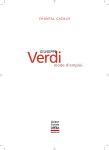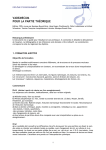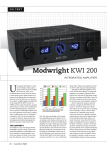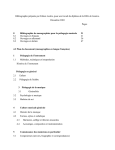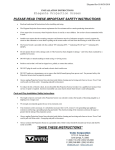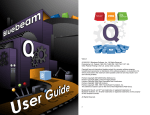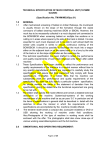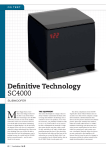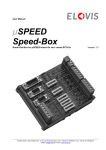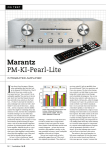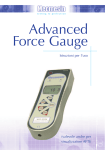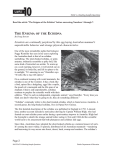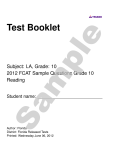Download Pro-Ject 6 PerspeX
Transcript
ON TEST Pro-Ject 6 PerspeX TURNTABLE P ro-Ject has been leading the way in budget-priced turntables for so long that it’s easy to forget the company also manufactures a fine line of higher-end turntables, such as the Pro-Ject 6 PerspeX reviewed here. It’s only fairly recently that turntable manufacturers have discovered the virtues of acrylics. In the case of Perspex, which is used extensively in the Pro-Ject 6 PerspeX, the prime acoustic advantages are that the material is dense and non-resonant. The cosmetic advantage is obvious: the Pro-Ject 6 PerspeX looks great! But the most significant technological advance on the Pro-Ject 6 PerspeX is that it uses a magnetic suspension to help isolate the platter and subchassis from the environment. All Pro-Ject turntables are manufactured in the European Union using production lines in the Czech Republic and Slovakia. Pro-Ject says it produces nearly all critical parts, including motors, chassis, bearings and tonearms in its own factories, and currently employs around 300 workers. THe eQuIPMeNT Although Pro-Ject is obviously using Perspex in the manufacture of the Pro-Ject 6 PerspeX, I should make it clear that Perspex is simply a brand name that describes one manufacturer’s version of a transparent thermoplastic material called polymethyl methacrylate (PMMA) that’s variously known as acrylic glass, acrylic, or Plexiglas. Many other high-end turntables also use PMMA in their construction, but from different manufacturers, so it’s also called Lucite, Optix, Acrylex, 22 Australian Acrylite, Acrylplast or one of half-a-dozen other names, depending on who made it. In essence, however, it all appears to be the same stuff… however, there can be important differences. One is that PMMA is quite soft and easy to scratch, so some manufacturers add an external scratch-resistant coating, using a process not dissimilar to that which your optician may offer you when you order a pair of spectacles with plastic lenses. For the record, I should also note that many audiophiles tend to treat PMMA as if it’s real glass. It isn’t, and the major operational difference here is that whereas glass has an extremely high resistance to most chemicals, including strong acids and alkalis, PMMA has quite low resistance to many quite ordinary cleaning solutions, so you should be extremely careful to use only cleaners that have been approved for use with plastics. I’d certainly never use any type of solvent for cleaning. If you need to clean the surface of the Pro-Ject 6 PerspeX, use only soapy water, or a mild cleaner such as Windex. I was interested to learn that although the chassis of the Pro-Ject 6 PerspeX is made from Perspex, the platter itself is made from MDF. Why not go the whole hog and make everything from Perspex? It appears that this is the subject of ongoing research at Pro-Ject, with designer Heinz Lichtenegger having experimented for many years with platters made of MDF, metal and acrylic, and in various combinations. His final word on the matter is that it’s not so much the material itself that has the greatest effect on the sound as the combinations of materials used in a turntable’s construction, and that it can vary depending on where it’s used, so that an MDF platter on an acrylic base will sound completely different to an acrylic platter on an MDF base. On the Pro-Ject 6 PerspeX, Lichenegger has introduced even more variables, because although the platter is made from MDF, its top surface is made from vinyl, which seems a little strange until you realise that it’s actually the perfect interface with a vinyl LP. The platter sits on an inverted, stainless-steel axled bearing tipped with a ceramic ball that rotates on a ceramic bearing plate. The bearing plate is let into the suspended sub-chassis, which is made of Corian, which in turn is partially suspended above the Perspex base plate by six magnets, formed in such as way as to make three magnetic field isolators. When I say ‘partially’ it’s because it seemed to me that although magnets are used, the sub-chassis is additionally supported by other, more physical means, including sorbothane padding. However, without actually completely disassembling the turntable, which I wasn’t prepared to do, I could not determine the exact nature of the other support mechanism. The platter is driven by a synchronous AC motor via a twostep pulley. The flat-edged belt loops around the outside edge of the platter. The 9cc ‘Evolution’ tonearm fitted to the Pro-Ject 6 PerspeX is an amazing arm. It’s almost completely made from carbon-fibre and has ball-race vertical and horizontal bearings. The result is that it’s so light-weight that moving it with your hand is a little like grasping air. Indeed the most significant mass Pro-Ject 6 PerspeX other than the counterweight is the phono cartridge itself, which on the sample supplied to Australian Hi-Fi Magazine for review, was the curiously named ‘Pick It’ PU-C-1H highoutput moving coil cartridge that is built specifically for Pro-Ject by Danish phono cartridge manufacturer Ortofon. It was apparently originally developed for midrange tonearms such as the Pro-Ject 8.6c and Pro-Ject 9c. It’s normally available separately for $329 (RRP) but distributor International Dynamics had fitted it specifically for the purpose of this review, at the specific request of the Editor. A low-output version of this cartridge is also available, for $269 (RRP). Phono cartridges are fairly costly items these days, so you’ll be very pleased to find that the Evolution arm has a magnetic catch that accurately and very effectively ‘locks’ the arm into the arm rest when it is not being used. The magnetic catch is so powerful that you’ll need to make a deliberate effort to dislodge the arm from the rest. However, if Speaking of counterweights, with the Evolution arm you get not one counterweight, but four! you’re looking at preventing stylus wear, the Evolution arm does not have any type of automatic ‘end-of-album’ arm-lifter mechanism, so you’ll need to use the very nice silicondamped manual arm lifter whenever you hear the tell-tale ‘clickety-click’ of the stylus entering the LP’s lead-out track. Speaking of counterweights, with the Evolution arm you get not one counterweight, but four! One (#28) is for cartridges weighing between 5–7.5g, one (#46) is for cartridges weighing between 7–10g, one (#43) is for cartridges weighing between 9–11g and the last (#29) is for cartridges weighing between 11–14g. The reason for having four is because the stub end of the tonearm (the short end on the other side of the pivot point) is much, much smaller than usual, so you can’t move the counterweight as far away from the pivot point as you can with most other tonearms, which severely limits the range of adjustment. Why is the stub end so short? One reason is that it reduces the moment of inertia of the arm, but it also minimises resonances, even though with this particular style of thinwall conical carbon-fibre construction, these are miniscule in any case. There’s a bit of overlap across the ranges because if you have to wind the counterweight out too far, it can actually foul the acrylic dust cover, in which case you’d step up to the slightly heavier counterweight, which would correctly balance the arm, and if you move the counterweight too far inwards, it fouls the tonearm base itself, which requires stepping down to a lighter counterweight. You wouldn’t know any of this from reading the Users Manual supplied with the Pro-Ject 6 PerspeX, because it says there are only two counterweights supplied with the turntable! It appears the Users Manual supplied with my review table was out of date. I downloaded the current version from Pro-Ject’s website and would recommend you do likewise. I found Pro-Ject’s User Manual a little confusing… but perhaps that’s just me. One issue I had with the instructions is that when installing the motor into the circular cut-out in the Perspex base, it was obvious that at some point someone had envisaged that the motor would be bolted to the base, because there’s a hole moulded through the turntable base at the appropriate spot, and the motor housing has a threaded hole in its base. However, I could not find any mention of this in the manual, nor could I find a bolt that could be used for this purpose in the installation kit of parts. Instead Pro-Ject supplies a ‘sticky’ sorbothane pad that should be interposed between the bottom of the motor and the Perspex base. Very mysterious. The Manual also mentions that if you don’t like manually moving the belt from one step of the pulley to the other when you want to switch platter speed from 33 to 45rpm, you can purchase a Pro-Ject SpeedBox or Speedbox SE and instead adjust speed electronically. Power for the drive motor is supplied by a wall-mounted plug-pack (a.k.a. ‘wall wart’) which is rated with an output of 16V at 500mA. IN use & lIsTeNING sessIONs I wasn’t a particularly happy camper after installing the Pro-Ject 6 PerspeX on a small side table I’d put alongside my main system to save me having to shift my own turntable. Despite having unpacked and assembled the Pro-Ject 6 PerspeX myself, I hadn’t realised that the three feet underneath (three feet rather than four, because three will be stable even if the surface on which you place the turntable is uneven) came to such sharp points. Such sharp points, indeed, that I accidentally scratched the expensive French polish finish on my side table. All my own fault, of course, but it puts me in a position to warn you not to do likewise! When checking the cartridge ON TEST alignment of the supplied cartridge, I have to say that I personally disagree with the description in Pro-Ject’s Owner’s Manual of how to set Vertical Tracking Angle (VTA). The manual suggests that VTA will be ‘correct’ when the tonearm tube is parallel with the LP record beneath it. This may certainly be true when using some phono cartridges, but it may not be correct for all phono cartridges. I would always recommend setting VTA so that at the correct tracking weight, the angle formed between the cantilever and the record surface is 22 degrees. (In most cases, you will find this geometry occurs when the top of the cartridge is parallel with the record surface.) However, it’s far more important to get Stylus Rake Angle (SRA) correct, and this involves actually examining the stylus itself, which should be tilted approximately 2 degrees away from the vertical so that it’s slightly forward (that is, the part of the diamond PRO-JECT 6 PerspeX BRAND: Pro-Ject MODEL: 6 PerspeX CATEGORY: Turntable RRP: $2,399 (Exc. Phono Cartridge) WARRANTY: Two Years DISTRIBUTOR: International Dynamics Australasia Pty Ltd ADDRESS: 129 Palmer Street Richmond, VIC 3121 1800 456 393 (03) 9429 0822 (03) 9429 0833 [email protected] www.internationaldynamics.com.au • Perfect pitch • Superb tonearm • Dust cover • Manual speed change • Suspension not completely magnetic • Spindle thread LAB REPORT Readers interested in a full technical appraisal of the performance of the Project 6 PerspeX should read the LABORATORY REPORT published on page 105. Readers should note that the results mentioned in the report, tabulated in performance charts and/or displayed using graphs and/ or photographs should be construed as applying only to the specific sample tested. Lab Report on page 105 avhub.com.au 23 ON TEST Pro-Ject 6 PerspeX Turntable stylus that’s fixed to the cantilever should be slightly further away from the tone arm pivot than the tip of the diamond stylus). This isn’t exactly a revelation: it’s an alignment developed by Maier and Risch ‘way back in the 80s, which they proved sounded superior to any other alignment methodology. [Editor’s Note: See the article ‘More than one VTA’ in Australian Hi-Fi Magazine, Volume 12 Number 5.] However, Pro-Ject’s Owners Manual is much better when it comes to advising about adjusting for azimuth angle, and it’s great that it’s so easy to do on the Evolution tonearm. All you have to do is adjust a small screw at the bearing end of the arm until the is the alignment that will result if you use a tool such as the Turntable Basics, Clearaudio or Align It Protractors. The Clearaudio and Align It protractors are fairly expensive tools ($425 and $199 respectively) but I would expect that any hi-fi dealer who is in the business of selling turntables and cartridges would have at least two of these three, and be able to use them to demonstrate that your cartridge has been correctly aligned. Any Pro-Ject dealer should certainly have a tool, because the Align It is made by Pro-Ject itself. It is almost identical to Clearaudio’s alignment tool, except that the Align It is made from, wait for it… acrylic. (The Turntable The pay-off comes when you spin up your first slab of vinyl and hear the sound quality, which is so supremely gorgeous that you will well have cause to wonder why the CD format became popular at all! I play so much vinyl that it’s no surprise to me at all, but I do just love it when friends come around, hear the music and ask “What’s that great CD you’re playing.” To see their faces when I tell them I’m playing vinyl is just unreal. It gets even better when there’s the time (and, truth be told, the motivation) for me to put on a proper ‘CD vs. LP’ demo, where they can clearly hear that when it comes to musicality, LP sound quality blows CD sound quality stylus (when viewed from the front, unlike SRA, which is viewed from the side) is exactly perpendicular to the record surface. As the manual correctly points out, you should not make this adjustment while the arm is in the groove. (Also, you should not make the common mistake most audiophiles make, which is to adjust SRA and azimuth while the stylus is resting on a mirror, in order to make the angles easier to see. This is not a good idea because it puts the entire weight of the tonearm and cartridge directly on the tip of the stylus, which can damage it. In use, a phono stylus is suspended by its sides, by the sides of the groove walls, so the stylus tip actually takes very, very little of the downwards tracking force.) Anti-skating adjustment is easy, because there are only three possibilities when using the 9cc Evolution arm. There is one setting to be used when using down forces of 10–14mN, another for down forces of between 15 and 19mN, and a final setting for down forces in excess of 20mN. Note that the use of milliNewtons for down force is technically correct, though it’s really only used in Europe. Australians will have to use a ‘grams to mN’ conversion table. (And it might have been nice had Pro-Ject supplied one in its Owners’ Manual.) During my alignment checking process, I discovered that the cartridge in my sample had been incorrectly aligned, so I had to do it all myself. I prefer to use the Bauerwald geometry when aligning cartridges, which Basics protractor is cheap at around $30 RRP, but it’s not suitable for use with the Pro-Ject Evolution arm because there’s no sight-line to the centre of the tonearm mount.) Amazingly, I also found that the cartridge pins had been incorrectly connected to the tonearm wiring loom, despite the clear and unambiguous colour coding on the cartridge, and the matching colour-coded tonearm wires. I reported these alignment and wiring issues to the editor, who passed the information on to International Dynamics, which subsequently advised that the person responsible is no longer employed with the company. While regretting this incident, International Dynamics also pointed out that in the normal course of events, all alignments are doublechecked by the dealer who sells the turntable, and that our review sample had skipped this part of the process, since there was no dealer involved. I should also point out that the last turntable I reviewed that was supplied from International Dynamics was perfectly aligned, in every respect, so this is obviously a one-off. As you can imagine, all this aligning, re-wiring and alignment cross-checking took quite a deal of time, which reminded me of at least one reason why the CD format was so popular when it was first introduced! However, alignment generally has to be done only when you fit a new cartridge and I guess that in reality, aligning a phono cartridge is no more arduous than the process of correctly positioning a new pair of speakers in a listening room. out of the water. My demos usually conclude with a lecture (some call it my highly politicised conspiracy theory polemic) explaining how certain foreign multinationals made sure CD became the predominant format by shutting down vinyl pressing plants and telling blatant porkies about the CD format: ‘Perfect sound forever’ is one that springs to mind! There was one final decision I had to make and that was whether to use the record clamp supplied, or ‘go naked’ and play LPs without it. I trialled this with/without scenario with several LPs, but the one I found that highlighted the subtle differences the best was Neil Young’s ‘Harvest Moon’ on Reprise. If you listen to the track Unknown Legend, you’ll hear a whole lot of fading echoes. With the clamp in place, these echoes sounded a little forced and artificial, whereas without it, there was a far more ‘dreamy’ quality to the sound. Which is correct? I’m not 100 per cent sure, but there sure is a difference! The same effect was also present on Brian Eno’s Ambient 4 (Polydor) but again although I heard differences, and preferred the sound without the clamp, I couldn’t be absolutely certain I was hearing what the record producer intended. I hate to leave this one up in the air, but I really couldn’t decide, and I did feel that the differences, although audible, were subtle enough that it probably doesn’t really matter (sacrilegious though that may sound). Of course if any of your LPs is even slightly warped, the answer then becomes a no-brainer: use the clamp! 24 Australian ON TEST Pro-Ject 6 PerspeX Turntable As it was, I happily played my way through my favourite vinyl, rediscovering great-sounding LPs that for some reason had fallen from my playlist (inevitable I suppose… there’s lots of music out there!). For example, I’d forgotten just how good the Classic LP version of Crosby, Stills & Nash’s self-titled LP really sounds on vinyl… particularly the harmonies. Ditto Anna Netrebko and Rolando Vilazon’s incomparable ‘Duets’ (on Clearaudio via DG). Then there’s The Complete Clapton, on ½-speed 180g vinyl, very possibly one of the greatest four-disc LP sets ever, IMHO. The Pick It PU-C-1H cartridge body is identical to the one Ortofon uses for its MC 1 Turbo and MC 3 Turbo cartridges, so I assumed it’s based on one or the other of these (or perhaps a mixture of both)? I was bothered by a slight mechanical noise on my Pick It, which turned out to be a loose exterior casing, which I solved with a dab of cyano-2 acrylate (that’s Superglue to you). Although I was more than happy with the performance of this cartridge (after I’d glued the case) I thought I should install one that I was more familiar with, and would also be even more revealing of the Pro-Ject 6 PerspeX’s performance, so I opted to fit an Ortofon Kontrapunkt A, partly because I had one to hand, and partly because I’d been informed it was an excellent match. I confirmed it was certainly an excellent match, and it certainly outperformed the supplied Pick It, but apart from confirming the Pro-Ject 6 PerspeX’s speed accuracy, and its lack of wow, flutter and rumble, it didn’t tell me much more about the turntable’s performance, other than the fact that you have no fear of ‘over-cartridging’ the ProJect 6 PerspeX: it will allow you to extract the maximum performance from any phono cartridge that’s compatible with the 9cc Evolution arm. As if there weren’t enough variables when it comes to turntables, there’s a final choice to be made with the Pro-Ject 6 PerspeX, which is whether or not to use the hinged acrylic dust cover that is supplied with it. There’s no doubt that using such a cover does introduce the possibility that the large surface area of the cover will ‘pick up’ air pressure variations in the room and transmit these down through the hinges into the turntable base, whereupon they could make their way back to the stylus/vinyl interface and potentially affect sound quality. Conversely, if you don’t use the cover, your LPs will become more dusty than they would if you did use the cover, which will mean more ticks and pops during playback… and/or more record cleaning. I found that the Pro-Ject 6 PerspeX is so well-isolated that I’d be happy to fit the cover, even allowing that it might have a small effect on sound quality, just to reduce my record-cleaning time. However, note that the magnitude of the effect on sound quality will depend on where your turntable is located with regard to your speakers and the volume levels at which you play. I used slow piano music to do the usual ‘ear test’ for wow and flutter and can report that I could hear neither so, so far as I’m concerned, there is no audible wow and flutter. I also listened for any background rumble, mainly using a Denon test record. Again, I couldn’t hear any background rumble. I also checked for absolute pitch (speed accuracy) and discovered that it was close enough to perfect that I could play along with LPs on my piano without any jarring discords. (However, if you like the idea of playing along with LPs, you should note that many LPs were not pressed at the ‘proper’ pitch, with the recording having been speeded up slightly to ensure the music ‘fitted’ neatly onto one side of the vinyl.) While I am speaking of rotational speed, I noted that Pro-Ject sells an optional 78 rpm pulley that will convert the Pro-Ject 6 PerspeX for 78rpm operation. This is an excellent and very thoughtful gesture on Pro-Ject’s part. Note, however, that if you do want to play back 78s, you’ll need to fit a phono cartridge that will accept dedicated 78 rpm styluses. Stanton is one of the very few phono cartridge manufacturers still making these, and it has a range of 78 rpm styluses specifically designed for its 500, 680 and 880 Series cartridges, of which I use the 500 series for the purpose. (If you want to stick with Ortofon models, you can use Ortofon’s OM78 cartridge.) I don’t like to conclude with a gripe, but I will. It’s that Pro-Ject has used quite a coarse thread on the spindle, and machined the thread a considerable distance down the spindle. Although this means you can quickly attach, tighten and remove the supplied record clamp, it also means that many after-market accessory clamps, weights and other accessories can’t be used, because they either won’t clamp to the threaded section of the spindle, or can’t be fixed so they’re exactly central. CONClusION This is a brilliant turntable. It does absolutely everything a turntable should, and in a stylish fashion… and even better, it comes pre-fitted with a superb—and completely adjustable—tonearm that will accommodate an enormously wide range of phono cartridges. Tom Hunter LAB REPORT PAGE 105 26 Australian Pro-Ject 6 PerspeX Turntable LAB REPORT SEE REVIEW ON PAGE 22 TesT ResulTs The rumble spectrum of the Pro-Ject 6 PerspeX is shown in Graph 1. The problem with measuring mechanical noise at very low frequencies is, of course, preventing external noise from contaminating the measurement. Most people will be familiar with hearing unwanted ‘rumbling’ sounds on CDs, where microphones have picked up trains passing in nearby subways, or the trams rumbling by. Since it’s virtually impossible to remove lowfrequency events, Newport Test Labs instead records the inherent level of background rumble at the exact time the test was made (which is shown as the black trace on Graph 1, and then superimposes the measurement of the inherent mechanical noise of the turntable itself (the red trace on Graph 1). Whereas it’s normally possible to filter out electrical interference, this is not possible with rumble measurements, so the obvious large peaks visible at 50Hz, 150Hz, 250Hz and 350Hz are mains hum components, caused by induced hum in the phono cartridge itself, as well as by hum in the test set-up. The smaller peaks at 100Hz, 200Hz and 300Hz are also hum-related, and so all should be ignored. As you can see, the rumble level of the Pro-Ject 6 PerspeX is only just higher than the level of background rumble, so that it’s about 55dB (unweighted) below reference below 50Hz, increasing to –80dB above 70Hz and to around –90dB above 125Hz. Rotational accuracy was outstandingly good, with the Pro-Ject 6 PersPex’s platter running just 0.02% fast at 33.33rpm and improving even more at 45rpm, where it was just 0.01% fast. As you can establish from dBFS 0.00 Graph 2, this is assessed by playing back a test LP with a signal recorded at exactly 3,000Hz and then measuring the frequency. So to give the results noted, at 33.33rpm, the Pro-Ject 6 PerspeX played back the test signal at 3006Hz, and at 45rpm, it played the test signal at 3003Hz. The Pro-Ject 6 PerspeX performed exceptionally well on Newport Test Labs’ test bench, with almost perfect speed accuracy Wow and flutter was also very low, with Newport Test Labs measuring rumble to the CCIR standard as being 0.05% (unweighted flutter), 0.09% (unweighted wow) and 0.07% (wow and flutter, weighted). The lab also measured to DIN standard, recording figures of 0.045% (flutter), 0.1% (wow), with DINweighted wow and flutter registering just 0.06%. These are all excellent results. Newport Test Labs also measured the frequency response of Pro-Ject Pick It’ PU-C-1H fitted to the Pro-Ject 6 PerspeX. The result is shown in Graph 3. Note the graph scaling at the left, which shows that the total graphing range is just 10dB. You can see that the cartridge’s frequency response is +2dB at 40Hz, after which it slowly falls to around –1.2dB at 1kHz, at which level it hovers until 5kHz, after which it rises to +5dB at resonance (18kHz) before falling to be +3dB at 20kHz. This puts the overall response at 40Hz to 20kHz ±3.1dB. Note that the lower frequency limit is not that of the cartridge, whose response actually extends down below 10Hz, but of the particular CBS test LP on which the frequency sweep is recorded. Distortion of the phono cartridge is shown in Graph 4, and you can see that it’s excellent, with a second harmonic distortion component at –30dB (3.0%), a third harmonic at –47dB (0.4%) and a fourth harmonic at –68dB (0.04%). The fifth, sixth and seventhorder harmonic distortion components are all around 65dB down (0.05%). Note how ‘clean’ the test signal at 1kHz is—as well as the distortion signals—which shows the lack of rumble as well as the stability and ‘levelness’ of the turntable platter. The final graph (Graph 5) shows the channel separation of the Pro-Ject Pick It PU-C-1H phono cartridge, referenced to 1kHz at 3.54cm/sec. You can see that it’s 22dB at 1kHz, which is a fair, but not ‘state-of-the-art’ result. Overall, the Pro-Ject 6 PerspeX performed exceptionally well on Newport Test Labs’ test bench, with almost perfect speed accuracy, extremely low levels of both wow and flutter, and very low levels of rumble—or, to put it another way—an excellent set of signal-tonoise ratios. Steve Holding dBFS 0.00 Newport Test Labs Newport Test Labs -10.00 -20.00 -20.00 -30.00 -40.00 -40.00 -60.00 -50.00 -60.00 -80.00 -70.00 -100.00 -80.00 0.00 Hz 50.00 100.00 150.00 200.00 250.00 300.00 350.00 400.00 2500.00 Hz dBr Newport Test Labs 4.00 2700.00 2900.00 3100.00 3300.00 3500.00 Graph 2. Wow and flutter profile, including speed accuracy, at 33.33rpm. Turntable runs 0.02% fast at this speed, playing back a 3kHz test signal at 3006Hz. At 45rpm, turntable runs 0.01% fast, playing back a 3kHz signal at 3003Hz. CCIR Flutter=0.05% unweighted. CCIR Wow=0.09% unweighted. Total wow and flutter = 0.07% CCIR weighted. [Pro-Ject 6 PerspeX Turntable] Graph 1. Rumble profile. Black trace shows inherent background noise at time of test, measured by placing phono stylus in groove of non-rotating LP. Red trace is same measurement, but with the LP rotating at 33.33rpm. The major peaks in the traces are the result of mains-powered induced hum in the phono cartridge itself, and in the test set-up and should be ignored. [ProJect6 PerspeX] dBFS 0.00 Newport Test Labs dBFS 0.00 -10.00 -10.00 -20.00 -20.00 -30.00 -30.00 -40.00 -40.00 -50.00 -50.00 -60.00 -60.00 -70.00 -70.00 Newport Test Labs 2.00 0.00 -2.00 -4.00 40.00 Hz 100.00 1000.00 10000.00 Graph 3. Frequency response of Pro-Ject Pick It PU-C-1H mounted in Pro-Ject Evolution tonearm fitted to Pro-Ject 6 PerspeX Turntable. -80.00 -80.00 0.00 Hz 4000.00 8000.00 12000.00 16000.00 20000.00 Graph 4. Phono cartridge distortion at 1kHz at 3.54cm/sec. Pro-Ject Pick It PU-C-1H mounted in Pro-Ject Evolution tonearm fitted to Pro-Ject 6 PerspeX Turntable. 0.00 Hz 4000.00 8000.00 12000.00 16000.00 20000.00 Graph 5. Channel separation of Pro-Ject Pick It PU-C-1H phono cartridge re 1kHz re 3.54cm/sec. with cartridge mounted in Pro-Ject Evolution tonearm fitted to Pro-Ject 6 PerspeX Turntable. avhub.com.au 105





